#RKLA
Explore tagged Tumblr posts
Link
via Jambiserucom : berita jambi seru detik hari ini terbaru viral
0 notes
Text

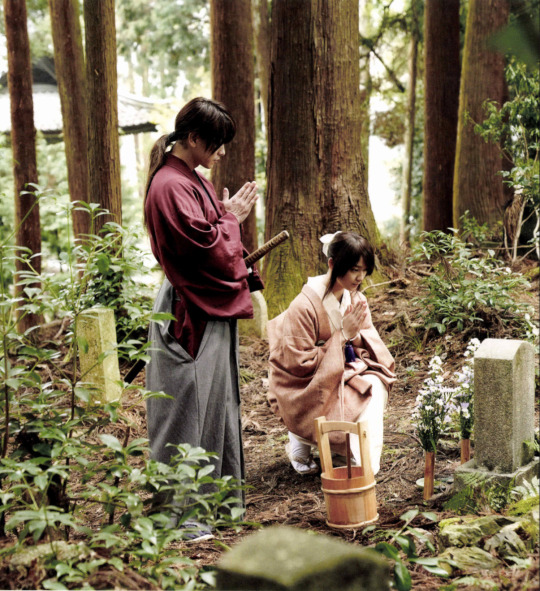

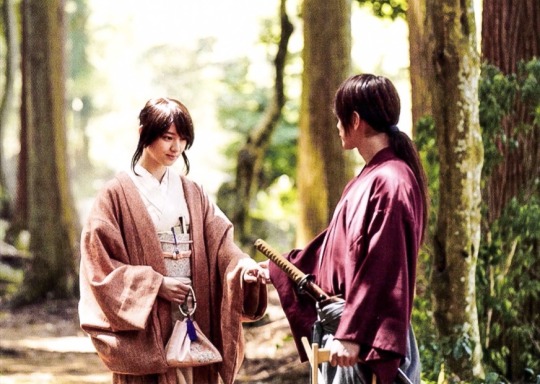

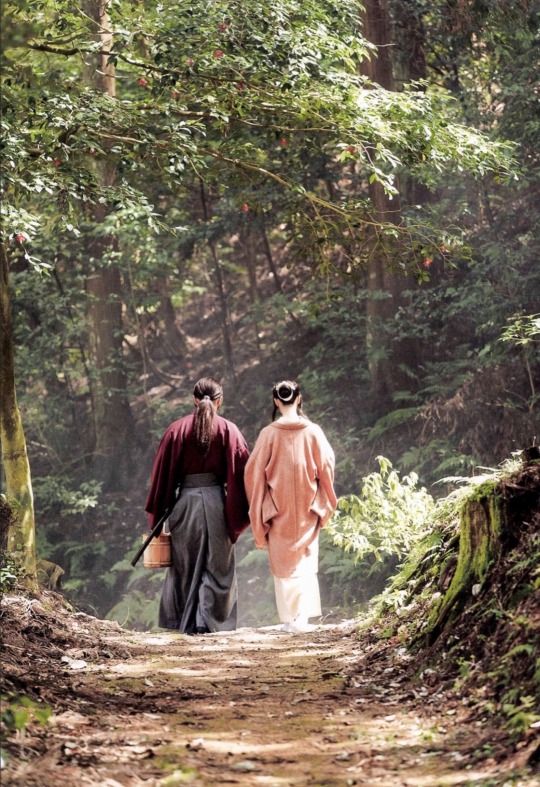
thank you, sorry, and... good bye.
#rurouni kenshin#rurouni kenshin live action#rk live action#rurouni kenshin the final#rkla#rkla2021#kenshin himura#kaoru kamiya#tomoe yukishiro
462 notes
·
View notes
Photo







Mackenyu Arata as Enishi Yukishiro | Rurouni Kensin: The Final Trailer
#Rurouni Kenshin#Rurouni Kenshin live action#rurouni kenshin the final#rkla#cinemapix#filmtv#moviegifs#filmgifs#jmovie#mackenyu arata#enishi yukishiro#I CANT WAITTTT#omg LOOK AT MACK#and i srsly cant believe we are getting JINCHUU ARC#Im so HYPEDDD#fave#mymymy#him choking kaoru thooooo#ohhh i wanna kill himmm#and i love that he got 3 outfits#LOVE ITTTT
508 notes
·
View notes
Photo


Takeru Sato being Kenshin being a happy Rurouni
(Rurouni Kenshin Live Action Movie: Kyoto Taika Hen 2014)
146 notes
·
View notes
Text

I'm still sulking with the live action
54 notes
·
View notes
Text
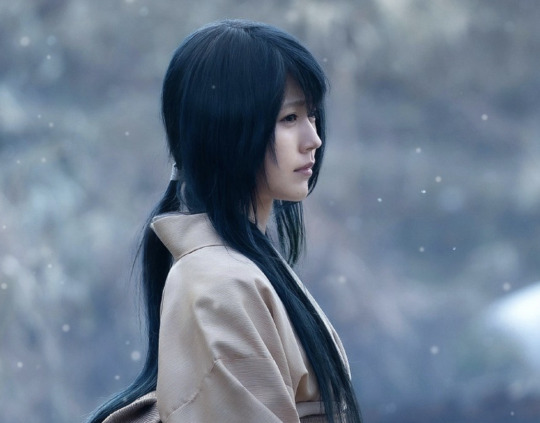
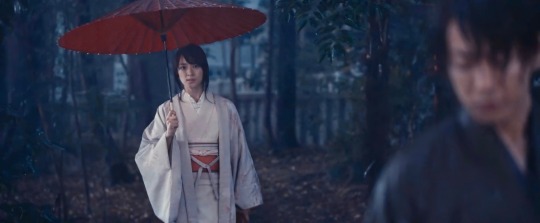
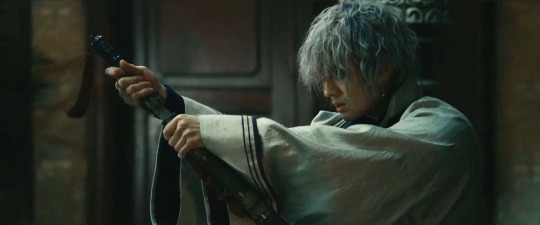
brilliant consideration!
I think it's very suggestive that Kaoru and Enishi clothes in new teaser are white color reminiscent of Tomoe.
Rurouni Kenshin Fight Sequence Analysis Series: Costume Designs

A sad reality about the film industry is that there are many departments that don’t get the recognition they deserve. After the big five categories are announced during the Oscars, (Best Writing, Picture, Actor, Actress, Director), many of us turn it off as the other elements aren’t as important to us. The truth is, there are many elements of filmmaking that aren’t necessarily conducive to praise or recognition because they are only noticed when done wrong. They are unsung heroes of the craft, since without them, some of our favorite movies wouldn’t be the same, and members of this group of unsung heroes are Costume Designers.
Costumes designers aren’t really noticed unless the costumes are terrible; their primary function is really to just set the world and sell it as a part of production design. Obviously, a person in 15th century Japan isn’t going to wear jeans and a hoody, otherwise it’d shatter immersion. That being said, however, there is a silent language to costumes, a hidden world of elements that we may not notice consciously, but our brains certainly do.
To recognize and study this language, we need to set out to ask and answer certain questions: How do costumes fit in with a film like Rurouni Kenshin? Is there a purpose beyond mere world building? Can they be a cinematic tool to tell a story? Can they be used to express character and if so, to what degree?
Today, we’re going to begin the search for answers to see how TeamOtomo used costumes to not only set and sell the world of RK, but to also see how it can be used as a grammatical element in the ever rich visual language of the film’s action sequences.
SPOILER SCOPE:
Kumiko, The Treasure Hunter Directed by David Zeller, Costume Designs by Kiersten Ronning and Tony Crosbie
Game of Thrones Season 5: “Unbowed, Unbent, Unbroken” directed by Jeremy Podeswa; Costume Designs by Michele Clapton
Star Wars Episode III Revenge of The Sith Directed by George Lucas; Costume Designs by Trisha Biggar
The Unsung Craftsman
Often times, especially in any industry where collaboration is required, part of doing your job right means no one will notice you at all. The production team gets almost as much flack as VFX designers in this industry; no one notices you and if they do, it’s not considered a good thing. Nevertheless, these people are craftsmen; they are artists that conceptualize and bring to life these imagined worlds that feel so beautiful and so lived in that for two hours or so, you forget that it’s not real. I know this kinda sounds like a crappy Oscar speech, but hey, its true! The craftsman we will be looking at today is Kazuhiro Sawataishi, the costume designer of the RK trilogy.

His short but high profile filmography includes work on the famous Takashi Miike film, 13 Assassins, before heralding the now famous and successful Rurouni Kenshin Trilogy.
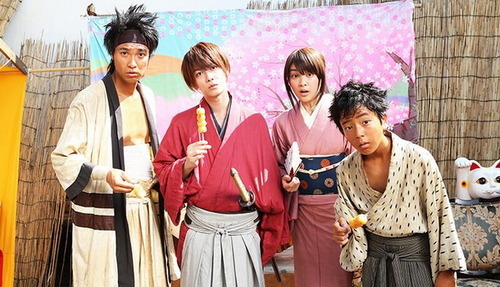
The responsibilites of a costume designer are particularly deceptive. On the surface, production design’s primary function is to build a world and make it believable and costumes have a major role to play in that. Some costume designs are so iconic that you don’t even need to have actually seen the films to recognize them. Consider the “Alien” (Xenomorph) by the brilliant H.R. Giger or John Mollo for his work on both the original Alien as well as the Original Star Wars Trilogy. That’s right, Darth Vader is his. We can look at the magical land of Oz and its wonderful costumes by Adrian Adolf Greenberg and many more. These costume designs are as iconic as films themselves and are testimony to the immense power and beauty behind the art of crafting the perfect costume and how essential to the film they can be.
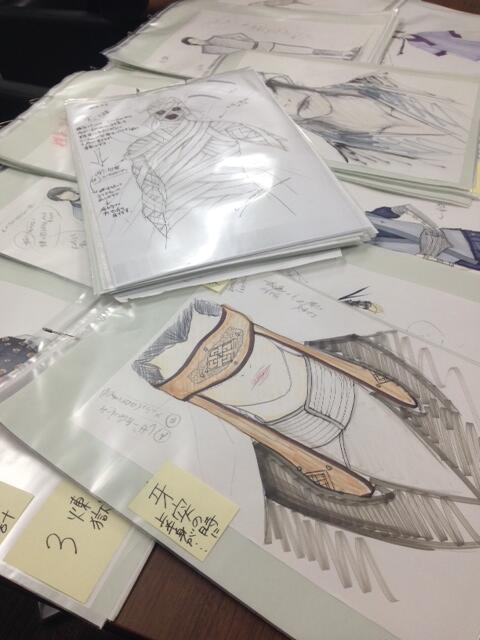
Rurouni Kenshin is absolutely no exception. A costume designer’s most obvious and supperficial responsibility is obviously designing the costumes themselves. They are artists in charge of the designs, deciding the color palette, fabric and texture, and fit for the actor’s build, choosing what to accentuate and what to deemphasis in accordance to the director’s vision. Their costumes, when actualized by their team, have to look good on camera and ensure that they portray the correct color when the Director of Photography lights it and so on. They also need to decide what to simulate, such as Shishio’s bandages which is closer to plaster than fabric according to an interview with Sawataishi. It can be pretty creatively taxing for everyone involved.
In some ways, Sawataishi’s work is made simultaneously easier and more difficult by the fact that the film is based on a manga. Otomo probably emphasized getting the costumes as accurate as possible to the original manga’s design, leaving only room for change if it was impractical for the actor or if it doesn’t test well on camera. It can be easier because he has to work off the designs of someone else, or it can be more difficult because those designs weren’t designed with a film in mind and he somehow needs to make it work for one. So essentially, Sawataishi needs to find a sweet spot between being true to the manga’s simplistic designs, making it at least easy for the actors to move, and make it consistent with the world Otomo and the Production Designers were.
But looking good isn’t the Costume Designers only concern, just the primary superficial one. Their main focus is actually character and story.
The Fabric of Emotions
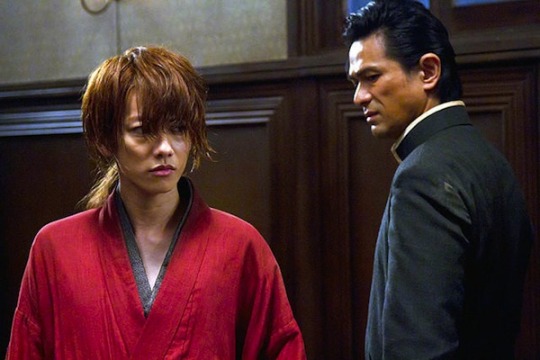
As readers of the visual poetry of cinema, we’re tasked with analyzing and considering the significance of certain stanzas of the poem itself. Traditionally (but by no means necessarily), a film needs to answer questions that it wants us to ask ourselves. “What kind of people are these characters? Can we identify them with costumes? How do the costumes add texture, context, and meaning to the visual landscape of the film we’re watching?” And perhaps the biggest question never asked: “Can we tell a story through costume design?”
Before we move on to RK, I want to invoke an example of character and visual storytelling in cinema through costumes. This is Kumiko, The Treasure Hunter, directed by David Zellner and costume designs by Kiersten Ronning and Tony Crosby.

Without spoiling too much of the plot, the character of Kumiko is an introverted one. She doesn’t fit in very well in contemporary Japanese society and the film even implies that she might have a form of Aspergers. To demonstrate visually the isolation she often feels, the costume designers Ronning and Crosby gave her a red jacket. Seems simple enough, except in the visual rules set by the film itself, Kumiko is assigned the color red. To enforce this, the director/DP are very careful about how much red we see thats not her. Having everyone else wear neutral and darker tones, the bright red contrasts with the otherwise neutral visual landscape, making her stick out like a sore thumb. The disproportional visual weight given to her by her color choice and the contrast it affords, we can pick her out and isolate her from a crowd because she doesn’t quite fit in the visual landscape, not unlike how her character doesn’t quite fit in the world she occupies.

Later in the first act of the film, she runs in to an old acquaintance who wants to catch up and talk. Here, she’s wearing a red scarf which immediately tips the audience off to a connection with Kumiko, due to us knowing by now that red is Kumiko’s color. This is a great example of how costume can enrich the visual grammar of a film. Even if you don’t speak Japanese, you can probably fill in the blanks without subtitles.
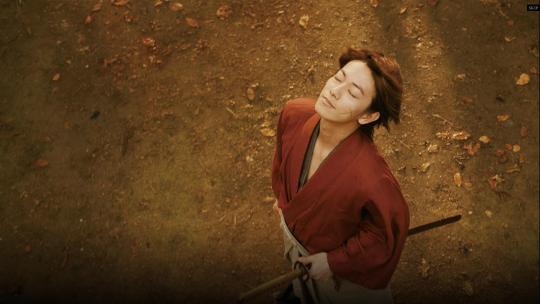
Sawataishi-san applies these same grammatical principles by giving Kenshin the color red. (Fun Fact: In Japanese media, red is considered the color of a hero, which is why many shonen protagonists in anime wear red.) No major characters in the trilogy wears red as a primary color except Seijuro Hiko in the third film, a major overhaul of the original Hiko design and a great visual cue that Seijuro Hiko will be the one to restore Kenshin’s faith in his own vows.

This is also why the color palette of Cho was switched to beige rather than his classic red. The red that manga fans grew up on is treated with reverence and significance as we see Kaoru give it to him with expository dialogue informing us that it belonged to her father. The writers of the trilogy reestablishes its significance when Megumi gives Kenshin the kimono later in the third film when Kenshin returns to Tokyo.
Beyond establishing the world and time these characters live in, it becomes a symbol of who he is as a human being and the ideals he carries. Its a symbol of the Rurouni, the wanderer who helps people, the man who protects the weak. The production team knew this; that’s what makes this shot from Kyoto Inferno so emotionally signficant after Kenshin leaves for Kyoto.

It shows us that Kenshin left behind all the ideals that the color red represents in the story and is now wearing black. The directing and camera placement puts us inside Karou’s head as she sees it first, and then we see “through her eyes”, putting us in her state of mind as well as setting up the moral conflict of the film, which will come to a head against Cho and then Shishio on the Rengoku. The red gi becomes as symbolic of Kenshin as a person as his sakabatou.
In these examples, we can see costumes telling us about the people who wear them and in Rurouni Kenshin’s case, what a character fights for and believes in. In Kyoto Inferno, we actually get something deeper: we get a subtle emotional response through the costume design. By treating the kimono and hakama with such reverence, the audience understands the significance and danger of Kenshin walking away from it.
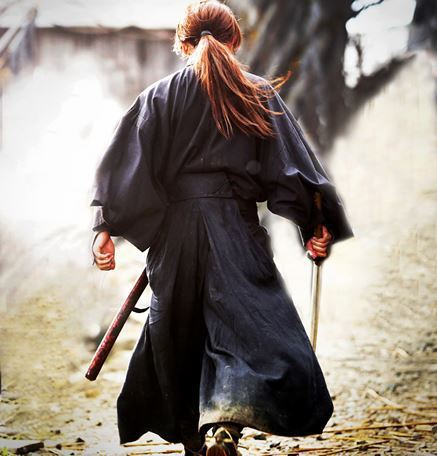
To take this matter even further, consider the fact that Kenshin is now wearing black. The only time we saw Kenshin wear black before heading to Kyoto is in flashbacks when he is Hitokiri Battousai. This is further exemplified when we flashback once per movie to the most significant moment the character has in that costume, which is the moment when he is confronted with the consequences of his assassinations as he watches Tomoe breaks down near Kyosato’s body. This reflects to us the challenges Kenshin will face as he heads down the road of death, where he will face the ever increasing odds of killing his opponents and being forced to choose between his vow and the necessity of his mission.


The visual idea of Kumiko’s acquaintance and her scarf is also used in RK, that idea being visual association. This is why Shishio’s men all wear blacks and greys except the Juppongatana. It’s why Kanryu’s samurai all look similar. Saito’s police uniform looks different from the rest of his men to show his rank without stating it, but the color palette is still similar, albeit brighter or bolder. It’s also why the Oniwaban wear deep blues and why Aoshi and Okina wear cloaks (or a coat in Aoshi’s case) with a similar color palette over their ninja outfits, establishing them as authority figures over their respective teams/groups. (Think back to Aoshi when he watched his group die.) We can tell who these groups are when we cut to fight scenes between them, especially in the set pieces involving multiple people. It is easier for us to keep track of who is fighting whom.
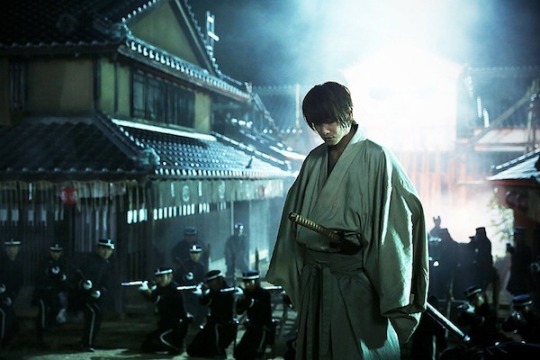
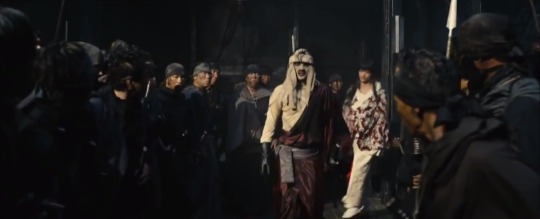
It makes it easier to understand who is fighting and in some cases, dying. It can also be used to denote rank, relationships, similarity, and even a character’s philosophy. We see it in other mediums like video games too when characters keep mementos that the audience associates with people the character lost.
We can tell a lot about a character just by what they’re wearing. Film however, has a more important demand in fight sequences for costumes, and this is one that is absolutely vital and can be understated unless its done improperly: Spatial Orientation.
Keeping Track: Spatial Orientation in Combat
For this last chapter, and the one that finally answers how costume is used for fight sequences, I’ll need to invoke a negative example. I’m going to preface this first by warning this may upset many of you, and I grievously apologize beforehand if I do since this is an unbelievably popular TV show….but as some may have guessed, I’m going to have to pick on Game of Thrones.
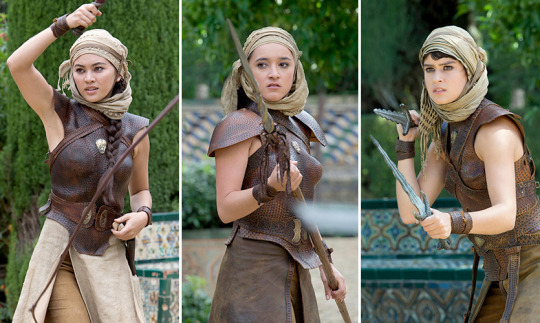
To get my personal feelings out of the way, in my opinion, season 5 had some of the crappiest action direction I’ve seen in a major production, which makes it ripe for the picking in demonstrating what RK does right. To illustrate my point as a negative reference, I’m going to call upon specific scene: Bronn and Jaime’s incursion with the Sand Snake sisters in Dorne midway through the season. I have taken the liberty of including a video of the fight in the bottom of this link; if you haven’t seen it, I encourage you to watch it before continuing to read. (For the record, this really hurt because Michele Clapton is actually pretty amazing).
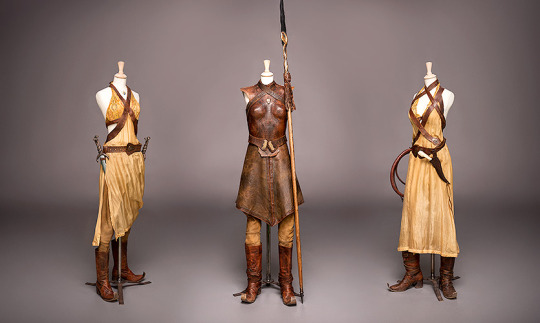
Most people think the editing and handheld camera is the problem with action scenes in movies today, and for the most part they’re right but that’s not the only or maybe even the most severe problem. Many shots in RK’s fight scenes are shot in handheld. The problem here is that aside from their weapons and a few different details, these characters are dressed nearly identically to each other. The differences are useless because when everything is shot and edited extremely quickly, those details can fly by and we not have established who these weapons and details are associated with in any concrete capacity yet. This is association done poorly.

Its true that earlier I said RK used costumes for association but just as important as looking similar when representing a group, especially during scenes with specific individual characters, they need to have a bit of contrast. Contrast is there so when the action starts, we can keep track of the major players of the scene and remain invested.
Jaime and Bronn are wearing more or less the same garb and are using the same type of weapon, while the Sand Snakes are wearing more or less the same armor, which instead of telling us anything specific about their characters, just lets the audience know that Jaime and Bronn are in a foreign land, and these girls are related to Oberyn Martell since they wear armor similar to the armor he wore in his fight with The Mountain in the previous season. (For non - Game of Thrones fans, please recall my previous entry in this series where I used Oberyn as an example for choreography and the placement of stunt doubles.)
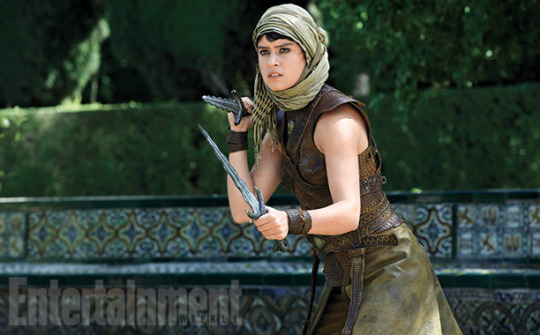

Looking too similar when inappropriate, espcially when improperly accentuated with bad editing and cinematography, can create a disastrous problem and violate a very important principle in filmmaking: the audience’s sense of space and orientation. In other words, the action is happening so quickly and is cut together in such a haphazard way that it’s extremely easy to lose track of who is who. It’s good to have similar costuming to show characters are on the same side in large battles or set pieces with multiple players, but when downscaled, it can distract the audience and pull you right out of what’s happening, and instead of manufacturing a tone or progressing the story, the audience can become really irritated or worse…bored. I’ll take a poorly executed film over a boring one any day.

What makes this example even worse is that later in the series, we’re treated to these costumes which look fanatastic and are actually individualized enough to tell them apart, but similar enough in style that you can still grasp the character’s cultural and perhaps even familial association. They are also heavily individualized in the books these charactes are based on.
With no visual grasp of anything concrete due to the editing and immesion consistently being shattered by the audience’s fruitless attempt to regain some sense of orientation, its difficult to be invested and this problem is only aggravated further when the characters look the same.

In the RK trilogy, every major fight Kenshin has that involve one to four other players not including himself, are not only stylistically different in direction, composition, design, choreography, and tone, but all of his opponents have differing costumes, often times contrasting with Kenshin. Kenshin also has the bonus of having red hair and a unique hair style, so if he’s fighting multiple opponents in similar colors, such as the opening of the first film, the Kyosato flashback, and Shingetsu village battle in Kyoto Inferno, his red hair is enough to diversify him from his opponents, so we never lose track of him or where he is, who he’s surrounded by, or where he’s going.


Soujiro and Kenshin, while they are both wearing cool colors, remain visually distinct from each other so when they entangle and their confrontation explodes into a flurry of swishes and slashes, we never lose track of them. The camera work and editing also helps as the action is clearly visible and the editor cuts on motion so we never lose grasp of what we’re seeing and what is happening.
And to rub salt in the wound, The Legend Ends also has a scene where 5 players in a fight are involved: the infamous 4 vs 1 finale against Shishio. Each character’s color palette, and costume designs are so diverse that losing track of them is actually rather difficult.

The biggest challenge they might face is that Aoshi and Saito would blend since they both wear blue, but this is easily rectified by having Aoshi wear his coat.

In the second movie, Sawataishi demonstrates his skill as a costume designer once more as he does what Game of Thrones aimed to do but actually executed it correctly. During Aoshi’s big fight, he removes his coat against Okina to emphasize that they’re on the same side visually; he keeps it or another layer of something similar in color and fabric on in every other action sequence. The reason he got away with this is both because of the differences in their age and hair color. Having them dress the same grants poignancy to the fight as we are given a reminder that they were once on the same side, multiplied even further by the fact that Misao wears the exact same colors when she walks in on their duel.

Anyway, because of this we can always tell who and where they are in relation to each other, keeping us routinely invested in the action. Instead of distracting, it becomes immersive and interesting. By getting out of the way and not drawing attention to itself, the costumes immerse us deeper into the action and more importantly, the story.
Final Thoughts: The World They Live In
Before we wrap up, we’ll discuss something that sets apart Sawataishi’s costuming from most of his competition and is probably why Otomo hired him. He does one thing that is sort of his trademark and honestly makes his costumes look fantastic: He lets actors get dirty.

He lets actors sweat into their costumes. They get cut and sewed up, torn, they get leaves in their wigs and so on. Otomo will also have the actors roll around in the dirt before doing a take to create a layer of authenticity. This layer of dirt can be seen in 13 Assassins too, another prolific film in Sawataishi’s filmography.

This authenticity sells the world to us and grounds it in believability. Contrasting with movies like The Last Samurai or the like, it removes any gloss or romanticization that often permeates in the chanbara or samurai genre since the fascination with Japanese culturei in the west grew.
Kurosawa was also paritcularly fond of his characters getting dirty too. It shows the audience that these combatants aren’t superhumans, even when they do superhuman things. They get tired, hot, beat up, and grimy. They probably smell bad too. They look like they can get worn out and actually get hurt. This creates tension, especially in the finales of Seven Samurai and The Legend Ends, such as when Kenshin and Shishio, battered and bloody, try to one-up each other despite being almost unable to stand or earlier in the film when Kenshin and his master roll around in the dirt.


His costumes, while we may not notice or pay mind to them, are a very important part of the RK verse that TeamOtomo created. Its a world not unlike our own but one where extraordinary people live in. It has a layer of grit and dirt to it that makes it feel so lived in and real. Its a minor detail, sure, but it makes every hit feel real, and makes use the actors’ probably real exhaustion to create tone and characterization.


This can be directly compare this with Star Wars Episode III Revenge of the Sith’s Mustafar duel. Anakin’s limbs were freshly amputated and Obi-Wan just finished fighting over lava and molten rocks and yet he barely has a glisten. Obi-Wan looks more put together than I do taking a brisk walk in a Floridian afternoon.
Sure, Obi-Wan seems to have broken a sweat, but he could’ve looked like that fighting in any location. Despite the sweat though, he doesn’t look very dirty for fighting a planet literally blackened by ash. His clothes look fine too, which is odd considering the intensity of their duel. I may be picking on this movie, but this really cheapens it for me, and removes a layer of depth Sawataishi afforded his films by letting actors get dirty to create authenticity and as a result, fails to sell the fact that they’re fighting on a molten planet, likely because the actors were actually fighting in a blue screen studio set.
The suspension of belief is potentially shattered because the fight doesn’t feel real and doesn’t seem like any of the characters are in any serious danger until the screenwriter decides they are, which is a shame given the emotional intensity of the scene. Heck, the aforementioned fight between Okina and Aoshi and that had far more narrative depth to me despite being thematically identical as both scenes were about betrayal. How much more emotionally impactful would the tragedy have been if Anakin or Obi-Wan looked like Shishio and Kenshin at the end of the duel?

These costumes are so important to cinema. They’re emblems of a world that costume designers, despite maybe not getting the respect they deserve in the grand scheme of film like actors do, work really hard to not only realize RK into a film trilogy, but to bring the RK world to life and make it a world we can believe, and one that we can come to love enough to revisit.
So next time you watch a movie, watch out for the costume designer and their team. What do their costumes say about their characters? How do they use it in an action scene? These are good questions I think, and ones worth asking. Keep watching guys, and thank you for reading!

Special Thanks
-To you guys for reading and making these cool graphics and screenshots. You’re also seriously bad ass and I wish I could credit everyone.
-To White-Plum for being a good friend and creating HYRK, the greatest avenue for me to write about this amazing series and a place where we can all gather in our love for RK.
and most importantly, to TeamOtomo, for bringing to life a manga that had been over for nearly 15 years, with no financial incentive other than to bring a comic we all love to life, with his wonderfully talented team.
DISCLAIMER: None of the images or gifs used are mine. These graphics have been crowd sourced through tumblr and google, making their original creators difficult to identify. If you see that I’ve used an image that belongs to you and you’d like proper credit, please contact me via private message with proof that it is yours, and I will update this post with a special thanks to you as well as credit and a link to your blog.
youtube
#Rurouni Kenshin#rurouni kenshin live action#rurouni kenshin the final#rurouni kenshin the beginning#RKLA#rk live action#Costume Design#Movie Costume#kenshin himura#kaoru kamiya#enishi yukishiro#tomoe yukishiro
321 notes
·
View notes
Text
I've been craving for a good e/k fanfic, but i think i've read all that there is on ao3 and ff.net..i reread some faves while waiting for new updates.still, there's none..so i decided to go and read k/k, my first otp (back when i didn't know e/k ship existed 😅)..and then i felt that old feeling again..being in love with my "ex otp"..may be it's partly because of the rk live action actors, takeru x emi, (i like them so much)..that's why i'm not so keen on watching the latest rkla, the beginning..i get so jealous that tomoe (kasumi) gets so intimate with kenshin...😭😫
7 notes
·
View notes
Photo

𝙇𝙞𝙛𝙚𝙨𝙩𝙮𝙡𝙚 𝙃𝙤𝙢𝙚 🍉𝙍𝙊𝙏𝙏𝘼𝙈𝙄 𝘽𝘼𝙎𝙎𝙄™🍉 #RottamiBassi™ #ScrapLow™ #home #porsche #bicycle (presso Italy) https://www.instagram.com/p/CZKiqa-rKLa/?utm_medium=tumblr
1 note
·
View note
Text



I’ll be on my way, Tomoe.



I'm home.
#rurouni kenshin#rk live action#rurouni kenshin live action#rkla#rkla2021#kenshin himura#rurouni kenshin the beginning#takeru satoh#emi takei#kaoru kamiya#He finally found his home.
300 notes
·
View notes
Video
After so many years of waiting, Jinchu is finally upon us.
youtube
Rurouni Kenshin: The Final Chapter | Trailer [ENG SUBTITLED]
Peace, JW
7 notes
·
View notes
Photo








Rurouni Kenshin: The Final
#Rurouni Kenshin#Rurouni Kenshin live action#rkla#chewieblog#cinemapix#filmtv#filmgifs#moviegifs#jmovie#satoh takeru#mackenyu arata#arimura kasumi#tao tsuchiya#emi takei#munetaka aoki#yu aoi#yusuke eguchi#himura kenshin#jinchu arc#enishi yukishiro#IM SCREAMING OMSDFLGHFDGAD#IM ABOUT TO HAVE A STROKEEEE#LOOK AT TEHEMMM#I CANT WAIT#OMFGDF I CANT WAIT#IM GONNA CRY AND SOB AND IM READYY#IMMA DIEEEEEEE#mymymy#rurouni kenshin the final
297 notes
·
View notes
Text
MEDAN-SUMUT | TRANSPUBLIK.co.id — Kabarhakam Komjen Pol Drs Agus Andrianto SH MH, menggelar memberikan Sembako kepada warga masyarakat Kota Medan Sumut yang layak menerimanya dari kaum Duafa, janda serta juga fakir miskin yang diselenggarakan melalui GEMMA (Generasi Muda Masjid) Sumut Indonesia untuk menyalurkannya kepada kaum Duafa, janda serta fakir miskin langsung oleh Pimpinan Wilayah Sumut Masdar Tambusai SAg bersama Tim Work.
Kabarhakam Komjen Pol Drs Agus Andrianto SH MH, dalam rangka memberikan Sedekah – nya, merupakan bentuk halnya atensi sosial kepada warga masyarakat Kota Medan Sumut, sebagaimananya bentuk sosialisasi Sembako berbagai macam ragam berupa yaitu:
Beras 5 Kg
Telur 1 papan
Minyak Goreng
Sabun Sunligh
Baca juga:
Pembagian Paket Sembako Oleh Hj Bunda Indah Bersama Majelis Taklim Halimah dan RKLA
Kabaharkam | Komjen Pol Drs Agus Andrianto SH MH Membagikan Sembako Disalurkan Melalui GEMMA Sumut Masdar Tambusai SAg Bersama Tim Work
Dengan menggelar melakukan penyaluran melalui GEMMA Sumut yang mewakili langsung dalam penyerahan oleh Masdar Tambusai SAg bersama Tim Work menyalurkannya kepada yang layak menerimanya kategori kaumnya Duafa, Janda serta Fakir Miskin di beberapa titik Kota Medan.
Di samping itu imbuhnya Masdar Tambusai SAg memaparkan dalam rangka halnya sebagai penyaluran Sembako ini adalah berupa atas Amanah Beliau Komjen Pol Drs Agus Andrianto SH MH, melalui Kami GEMMA Sumut mewujudkan program kegiatan ini untuk disalurkan terhadap beberapa titik warga masyarakat Kota Medan Sumut yang khalayak sebagai pantas menerimanya serta yang membutuhkan nya.
Sebagaimana beliau sudah penempatan bertugas di Mabes Polri serta masih mengingat juga beliau kepada warga masyarakat Kota Medan Sumut, sebagaimana sebelumnya tugas di Mabes Polri, Beliau adalah Kapolda Sumut yang selalu melakukan atensi sosial Sedekah pembagian Sembako dengan halnya bentuk kepedulian terhadap warga masyarakat Kota Medan Sumut yang seyogyanya khalayak membutuhkan kepada menerimanya tersebut.
Baca juga:
Kapolres Batu Bara AKBP H. Ikhwan Lubis SH. MH, Memimpin Langsung Bagi-Bagi Masker Gratis dan Penyemprotan Disinfektan di Tanjung Tiram
“Untuk itu mari kita selaku warga masyarakat Kota Medan Sumut yang mendapatkan sedekah rasa sosial ini merupakan beliau masih mengingat kita walaupun sudah bertugas di Mabes Polri, dengan begitu mari kita bersama-sama mengucapkan Ribuan Terima Kasih sebesar-besarnya kepada Kabarhakam Beliau Komjen Pol Drs Agus Andrianto SH MH, serta atas Do’a kita semua semoga selalu di limpahkan Rahmat, Rezeki serta Kesehatan begitu keluarga beliau serta merta juga semoga InsyaAllah beliau selalu di Tinggikan derajat nya serta juga dalam lindungan ‘Tuhan Yang Esa (Allah SWT), Amin Ya Rabbal Al Amin’,” tutur Pimpinan GEMMA Sumut Masdar Tambusai SAg.
Demikian halnya kegiatan tersebut mulai setelah Sholat Jum’at (27/3/2020) s/d bertahap hari ini semoga sukses serta berjalan lancar keseluruhan tanpa ada hambatan, Amin Ya Rabbal Al Amin.
(TP/Loebis)
Kabaharkam | Komjen Pol Drs Agus Andrianto SH MH Membagikan Sembako Disalurkan Melalui GEMMA Sumut Masdar Tambusai SAg Bersama Tim Work MEDAN-SUMUT | TRANSPUBLIK.co.id -- Kabarhakam Komjen Pol Drs Agus Andrianto SH MH, menggelar memberikan Sembako kepada warga masyarakat Kota Medan Sumut yang layak menerimanya dari kaum Duafa, janda serta juga fakir miskin yang diselenggarakan melalui…
0 notes
Photo
Looking for doujinshi instead of watching RKLA the beginning 😭








Kaoru was a very kind woman.
- Ache, Chapter 18 by @mamoro2202
.
.
.
I actually made a doujin *gasspppp*!!
This took far longer than I anticipated, but I thoroughly enjoyed the process. I have newfound respect for mangakas, because truly every panel is a work of art made with every bit of love and care as deserving of standalone pieces.
Done in Photoshop, almost entirely by hand (tablet), with only two custom brushes. If I’d known better I would have used something like MediBang Paint which actually has screen tones. Maybe next time.
Many thanks to Mamoro for the gift of her beautiful writing, for allowing me to illustrate one of her fic’s chapters, and giving input/guidance during the production process.
If you enjoyed this please REBLOG and share with other RK fans!
377 notes
·
View notes
Link
0 notes
Text
Kaoru was in four RKLA movies, yet her role feels so underrated. 😤
1 note
·
View note
Text



Rurouni Kenshin: The Final (2021)
#rurouni kenshin#rk live action#rurouni kenshin live action#rkla#rurouni kenshin the final#rkla2021#emi takei#mackenyu arata#kaoru kamiya#enishi yukishiro
322 notes
·
View notes